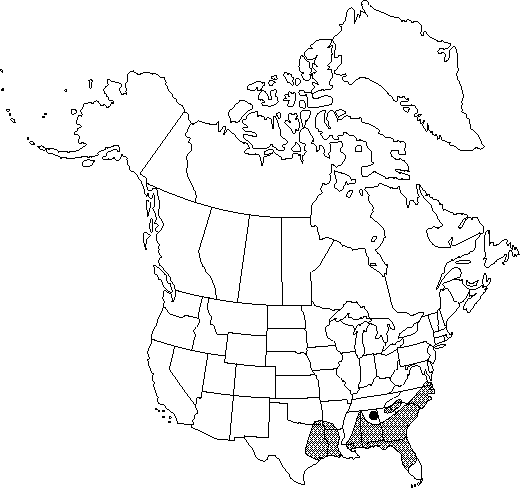Difference between revisions of "Quercus incana"
Travels Carolina, 378. 1791.
FNA>Volume Importer |
imported>Volume Importer |
||
| (5 intermediate revisions by 2 users not shown) | |||
| Line 9: | Line 9: | ||
|common_names=Bluejack oak | |common_names=Bluejack oak | ||
|special_status={{Treatment/ID/Special_status | |special_status={{Treatment/ID/Special_status | ||
| + | |code=W1 | ||
| + | |label= | ||
| + | }}{{Treatment/ID/Special_status | ||
|code=E | |code=E | ||
|label=Endemic | |label=Endemic | ||
}}{{Treatment/ID/Special_status | }}{{Treatment/ID/Special_status | ||
|code=F | |code=F | ||
| − | |label= | + | |label=Illustrated |
| − | |||
| − | |||
| − | |||
}} | }} | ||
|basionyms= | |basionyms= | ||
| Line 22: | Line 22: | ||
|name=Quercus cinerea | |name=Quercus cinerea | ||
|authority=Michaux | |authority=Michaux | ||
| + | |rank=species | ||
}} | }} | ||
|hierarchy=Fagaceae;Quercus;Quercus sect. Lobatae;Quercus incana | |hierarchy=Fagaceae;Quercus;Quercus sect. Lobatae;Quercus incana | ||
| Line 46: | Line 47: | ||
-->{{#Taxon: | -->{{#Taxon: | ||
name=Quercus incana | name=Quercus incana | ||
| − | |||
|authority=W. Bartram | |authority=W. Bartram | ||
|rank=species | |rank=species | ||
| Line 60: | Line 60: | ||
|publication title=Travels Carolina, | |publication title=Travels Carolina, | ||
|publication year=1791 | |publication year=1791 | ||
| − | |special status=Endemic; | + | |special status=W1;Endemic;Illustrated |
| − | |source xml=https:// | + | |source xml=https://bitbucket.org/aafc-mbb/fna-data-curation/src/2e0870ddd59836b60bcf96646a41e87ea5a5943a/coarse_grained_fna_xml/V3/V3_966.xml |
|genus=Quercus | |genus=Quercus | ||
|section=Quercus sect. Lobatae | |section=Quercus sect. Lobatae | ||
Latest revision as of 21:52, 5 November 2020
Trees, deciduous, to 10 m. Bark dark brown to black with square plates. Twigs brown to reddish brown, 1-2.5 mm diam., tomentose to sparsely pubescent. Terminal buds light brown to reddish brown, narrowly ovoid to conic, 3.5-7 mm, distinctly 5-angled in cross section, scales pubescent, often tuft of reddish or silvery hairs at apex. Leaves: petiole 2-8(-10) mm, tomentose. Leaf blade narrowly ovate or elliptic to obovate, usually widest near middle, planar, 30-100 × 12-35 mm, base acute (rarely attenuate) to rounded, margins entire, with 1 apical awn (leaves on juvenile or 2d-flush growth may have 2-3 shallow lobes and 3-5 awns), apex acute or obtuse, rarely rounded; surfaces abaxially densely tomentose, hairs in vein axils often reddish, easily distinguished from others, adaxially often glossy, sparsely pubescent, especially along midrib and near base, veins often raised. Acorns biennial; cup saucer-shaped to bowl-shaped, 4.5-8 mm high × 10-18 mm wide, covering 1/4-1/3(-1/2) nut, outer surface pubescent or puberulent, inner surface uniformly pubescent, scale tips tightly appressed, obtuse or acute; nut ovoid (rarely subglobose) to broadly ellipsoid, 10-17 × 10-16 mm, occasionally striate, glabrate, scar diam. 5.5-10.5 mm.
Phenology: Flowering spring.
Habitat: Well-drained sandy soils of barrens, hammocks, dunes, and upland ridges
Elevation: 0-250 m
Distribution

Ala., Ark., Fla., Ga., La., Miss., N.C., Okla., S.C., Tex., Va.
Discussion
Quercus incana reportedly hybridizes with Q. falcata [= Q. ×subintegra (Engelmann) Trelease], Q. hemisphaerica (D. M. Hunt 1989), Q. laurifolia (= Q. ×atlantica Ashe), Q. laevis (= Q. ×asheana Little), Q. marilandica (= Q. ×cravenensis Little), Q. nigra (= Q. ×caduca Trelease), and Q. phellos (E. J. Palmer 1948); with Q. pumila (D. M. Hunt 1989); and with Q. velutina (= Q. ×podophylla Trelease), and questionably, Q. myrtifolia.
Selected References
None.
